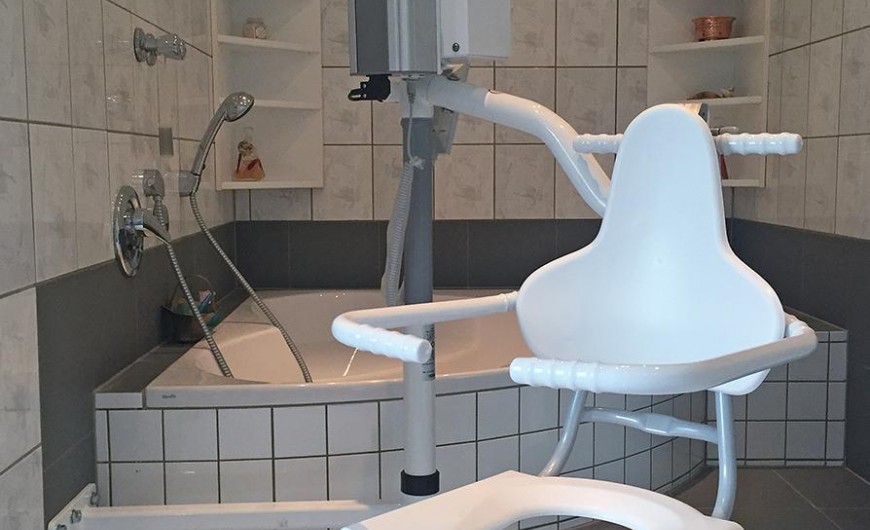Bath hoists have evolved in recent years, making life easier for private homes and care environments alike but it's important to not compromise safety, comfort or aesthetics to get the right level of support.
Here are the 5 most common problems we see with bathing hoists and how Autolift can help solve them.


Problem 1: Bathroom layout makes it difficult to fit the hoist
Most bath hoists are fitted using a standard floorplate, which means the bathroom has to have enough space- in the right place- for the dimensions needed to support the hoist. This can be a challenge depending on bathroom size and layout (for example, if there's a cupboard in the way or the bath is too close to the wall).
Models like the Autolift bath hoist solve this problem with custom floor and wall fixings to suit any floor type. This means that – no matter the bathroom design – you can fix the hoist properly. It’s a major step forward in helping bathrooms feel more personal and less like a stereotypical ‘care environment’.
Problem 2: Standard arm lengths don’t work for ‘standard’ baths
This is related to Problem 1 because it’s linked to a design challenge. Given the trends for corner baths and for slightly wider and longer standard baths, we talk to many OTs and carers who struggle to get enough reach on the bath hoist.
Look for a bath hoist that can be used at the end of the bath, at the side of the bath and with corner baths. This gives you flexibility as needs evolve. Having a slightly longer arm also means you can take advantage of larger standard bath sizes, which are easier for carers and more comfortable for users.
Problem 3: Transferring is difficult
Most common bath hoists have a base and then a seat that goes up and down. This means that users have to swing their legs round 90 degrees and position themselves correctly at the back of the seat. This can be a difficult transfer for those with higher levels of need.
The Autolift bath hoist rotates 360 degrees, with column locks at 90-degree intervals. This means users can transfer into the seat comfortably from outside the bath, and then be rotated for accurate positioning within the bath. Plus, the seat rises high enough that they don’t have to swing their legs higher to get over the side. As a result, the transfer process is easier and more comfortable.
Problem 4: The hoist doesn’t last as long as you’d like
Bathrooms are humid environments, which means that metal components are susceptible to rust. And many hoists only have a 12-month warranty, which can lead to rising costs when that runs out (either through topping it up or dealing with repairs).
Look for stainless steel and brass, which offer a much more robust solution than the standard mild steel and powder coating. This is a crucial point if the equipment could be recycled in future, because it has a longer lifespan. (And as a note, we offer 3 years’ parts and labour warranty as standard, so not only does the hoist last longer, but you get better value on the warranty as well).
Problem 5: It’s hard to recycle the hoist because of varying user needs
The floorplate issue in Problem 1 is one element here, as is the lifespan issue in Problem 4. But another critical aspect of recyclability is the adaptability of the power unit and the seat.
Autolift works with both manual and electrical power units, and it’s easy to swap them out. That way the hoist itself can be easily recycled, with the required power unit fitted after installation. This is the same when it comes to the seat – there are both fixed and removable mobile seat options that can be configured based on user needs.
Learn more about Autolift and bath hoist options for your application
You can read more here or contact a product advisor on 0845 658 8411.

Latest Blog Posts
Seasonal opening times 2025/26
2025 Holiday Season Update - Our team are here for you but we will be taking a break between the 24th December and 2nd January 2025.

New Shower Chair Innovation
Experience Wealden Rehab’s new shower chair innovation at the OT Show 2025

Responsive Care Equipment Supplier Across the UK
Supporting hospitals and care providers in unsettling times ...

NAEP Conference 2025
Meeting Occupational Therapists, Commissioners and Exploring Bariatric and Paediatric Solutions

Our Seasonal opening times 2024/25
Our team are here for you but we will be taking a break between the 24th December and 2nd January 2025.

Can a RAZ shower chair rust?
Get an in-depth look at the RAZ shower chair range and the protective features that make them built to last



